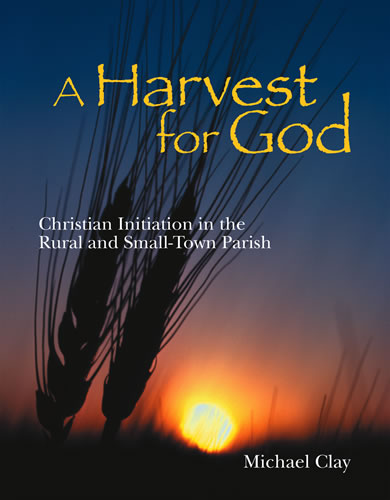 Diana and I recently attended the 2014 Federation of Diocesan Liturgical Commissions, and we heard a presentation by Fr. Paul Turner on the current status of the implementation of the Rite of Christian Initiation of Adults in the United States. Fr. Turner was commenting on a report by the Center for Applied Research in the Apostolate on current pastoral practice.
Diana and I recently attended the 2014 Federation of Diocesan Liturgical Commissions, and we heard a presentation by Fr. Paul Turner on the current status of the implementation of the Rite of Christian Initiation of Adults in the United States. Fr. Turner was commenting on a report by the Center for Applied Research in the Apostolate on current pastoral practice.
In his presentation, he made six points:
- Adaptation strengthens worship.
- Catechetical formation accompanies liturgical practice.
- Ministries are diversified.
- The sequence of the initiation rites reveal the paschal mystery.
- Uncatechized Catholic adults need appropriate pastoral care.
- Other Christian assemblies share a valid baptism with Catholicism.
Adaptation strengthens worship
In this post, I’m going to cover the first point, adaptation strengthens worship. The Rite of Christian Initiation of Adults, Fr. Turner said, “is an outstanding example of a liturgical text that made room for adaptation.” The adaptability of the rite has both plusses and minuses in actual pastoral practice. On the plus side, each parish assembly is encouraged to make the rite its own, adapting words, gestures, and symbols to inculturate meaning for its particular community and group of catechumens.
On the minus side, some parish leaders lack the knowledge or skill to make appropriate adaptations and, as a result, either adhere slavishly to text and ritual that were meant to serve only as examples or veer far afield from the proper implementation of the ritual based on something they saw at a workshop or that was handed down to them by previous, equally unskilled parish leaders.
An example of slavish conformity is the opening dialogue in the Rite of Acceptance, which begins with the presider asking the catechumens, “What do you ask of God’s Church?” Many parishes rehearse the catechumens in the exact dialogue given in the ritual text, which is clearly meant to be only an example and not delivered verbatim.
An example of taking adaptation much too far is the somewhat common practice of requiring the inquirers to knock on the church door in order to gain entrance. This appears nowhere in the rite, nor should it. Fr. Turner critiqued this, saying, “This practice supported the passive idea that the way Catholics get new Catholics is to sit in church and wait.”
How much can we adapt?
The question most RCIA teams have is, how much can we adapt the rites to our particular situation without disrupting the meaning and structure that keeps us in unity with the universal church.
By its very nature, that question cannot have one single answer. Every parish is different, and the level of adaptation required will vary. But you can find an answer for your particular situation. And the way to do that is to read.
Four things to read
 First of all, read the Rite of Christian Initiation of Adults itself. The text has a very readable pastoral introduction to every rite you will be celebrating. The introductions describe the essential elements of the rite and the core purpose of the rite. If you are grounded in the basics, it becomes easier to identify helpful vs. unhelpful adaptations.
First of all, read the Rite of Christian Initiation of Adults itself. The text has a very readable pastoral introduction to every rite you will be celebrating. The introductions describe the essential elements of the rite and the core purpose of the rite. If you are grounded in the basics, it becomes easier to identify helpful vs. unhelpful adaptations.
![CelebratingInitiationTurner-150x224[1]](https://teaminitiation.com/wp-content/uploads/2014/10/CelebratingInitiationTurner-150x2241-1.jpg) Next, read commentaries on the RCIA. A good commentary will help you think about the rite along with someone who has vast experience and knowledge about making appropriate adaptions. Fr. Turner has written an excellent one titled: Celebrating Initiation: A Guide for Priests. Don’t be thrown off by the words “priests.” Every person on your RCIA team will benefit from Fr. Turner’s clear, common-sense writing and thinking about celebrating the rites of initiation.
Next, read commentaries on the RCIA. A good commentary will help you think about the rite along with someone who has vast experience and knowledge about making appropriate adaptions. Fr. Turner has written an excellent one titled: Celebrating Initiation: A Guide for Priests. Don’t be thrown off by the words “priests.” Every person on your RCIA team will benefit from Fr. Turner’s clear, common-sense writing and thinking about celebrating the rites of initiation.
 If I may, I would also suggest my book, The Way of Faith: A Field Guide for the RCIA. In that book, I cover all of the aspects of implementing an initiation process in your parish, which is much more than just celebrating the rites. However, a major portion of the book is devoted to how to celebrate the rites and make smart adaptations that will enhance the participation of your worshipping assemblies. I wrote the sections on the rites with “non-liturgists” in mind so that even those with very little ritual training can make successful adaptations for their particular situations.
If I may, I would also suggest my book, The Way of Faith: A Field Guide for the RCIA. In that book, I cover all of the aspects of implementing an initiation process in your parish, which is much more than just celebrating the rites. However, a major portion of the book is devoted to how to celebrate the rites and make smart adaptations that will enhance the participation of your worshipping assemblies. I wrote the sections on the rites with “non-liturgists” in mind so that even those with very little ritual training can make successful adaptations for their particular situations.
 And finally I would recommend Fr. Michael Clay’s A Harvest for God: Christian Initiation in the Rural and Small-Town Parish. Again, don’t let the title throw you off. Even large, urban parishes can learn skills for adapting the rites from Fr. Clay’s examples and case studies.
And finally I would recommend Fr. Michael Clay’s A Harvest for God: Christian Initiation in the Rural and Small-Town Parish. Again, don’t let the title throw you off. Even large, urban parishes can learn skills for adapting the rites from Fr. Clay’s examples and case studies.
The reason for adapting the rites—initiation rites or any other rites—is not to be trendy or cool. The reason is because adaptation strengthens worship. The Constitution on the Sacred Liturgy—the first document published by the Second Vatican Council—enshrined the principle of adaptation in the liturgical reform (see CSL 39). We can neither ignore the principle of adaptation or abuse it. Knowing the difference requires a a lot of prayer and a little bit of reading.
What is your experience?
How do you decide what adaptations to make in the rites? Please share some of your experience with the rest of us.








I think the best adaptation happens when the presider has really studied the dialog and prayers. When the presider can make the words his own and be comfortable with the ritual and text, the rite flows and the assembly is engaged.
The statement about the “door knocking” jarred me. I am going to find a more suitable way to introduce those to be accepted this year.
In the early ’80’s I had the privilege of driving Rev Balthasar Fischer to Chicago O’Hare after a series of seminars on the RCIA at the University of Notre Dame. (Fischer chaired Study Group 22, the group who did the groundwork on the catechumenate for Vatican II and the actual revision after the Council.) We discussed adaptation of the rites. (At the time a big issue was moving the Romans 6 reading to after the baptisms & confirmations [a recognition that it is the first mystagogical lesson]). Fisher’s response was “do what works in your particular worshiping community.”
Granted, Fisher had just participated in a series of seminars with graduate students focused on baptismal liturgy and his driver had been working “in the field” in the local diocese for several years, so his response may seem too simplistic. Personally, I found and continue to find, it a wise response.
The parameters you set in this article make sense. It is good to have the “cookbook” to start with but, with experience, one can adapt to the needs of the particular congregation and the needs of the particular group you have at any given time.
We adapt all the time. In fact, in addition to the RCIA, we look at the Episcopal, Lutheran and Presbyterian rites when we are working on specific rites in a specific year. For example, look at the “Affirmation of the Vocation of the Baptized in the World” given to us by the ELCA as a great way to complete Mystagogia (Welcome to Christ; Lutheran Rites for the Catechumenate; Augsburg Fortress, 1997).
One of the principles I use to make adaptations is that the ritual words and actions be heard and seen. To this end, I have the catechumens and candidates spread throughout the church as they are signed on their senses by their sponsors (an optional part of the Rite). Also I endeavor to engage the congregation by giving them a speaking part such as the affirmation that they too will pray for and support the candidates on their journey of faith.
We do not have the catechumens leave Mass after the Liturgy of the Word. The historical reasons for doing so no longer exist. Many of our catechumens have been coming to Mass with their husbands or wives and children, or with friends, and now they have to leave Mass, leaving family in the pews as they depart. The candidates remain for the entire Mass, leading to a division in the RCIA community and in the catechesis. Our catechumens stay for the entire liturgy, receive a blessing from the priest at communion time, and then our catechesis following the Sunday Mass includes not only the Liturgy of the Word, but the Liturgy of the Eucharist as well. Prayer, faith sharing, formation and information is available to both candidate and catechumen at the same time. I would like to see the RCIA instructions begin to address this with a 21st century mindset. We do not need to be protected from catechumens any longer…they are not infiltrators or a “moles” trying to persecute Christians. If small children stay for the entire Mass, why not adult catechumens? If non-Catholic visitors can stay for the entire Mass, why not adult catechumens?
We had the privilege of having Fr. Paul Turner as our leader on our Beginings and Beyond week long workshop in Villa Park, CA. He and the Forum team had many interesting ideas on adaptation, i.e. having the elect bake the Eucharistic bread, decorate the candle etc. We tried some of the adaptations but have since moved on to simpler methods. It was just way too much time to ask of the elect before holy week and the bread never came out properly unleavened,
We adapted through our own experience as well as what we would witness at other churches that seemed to work well. Having the elect and sponsors outside after each scrutiny handing out prayer cards asking people to pray for them stands out as one thing we borrowed from another parish.
Just keep watching to see what works and what doesn’t.